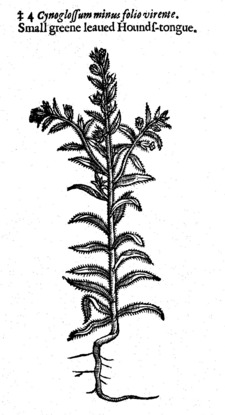
Gerard's Herbal - Part 3

Fig. 1190. Kinds of Hound's-Tongue (1-4)
The Description.
1. The common Hound's-Tongue hath long leaves much like the garden Bugloss, but broader, and not rough at all, yet having some fine hoariness or softness like velvet. These leaves stink very filthily, much like to the piss of dogs; wherefore the Dutch men have called it Hunds pisse, and not Hound's-tongue. The stalks are rough, hard, two cubits high, and of a brown colour, bearing at the top many flowers of a dark purple colour: the seed is rough, cleaving to garments like Agrimony seed: the root is black and thick. These plants for one year after they come up of seed bring forth only leaves, and those pretty large; and the second year they send up their stalks, bearing both flowers and seed, and then usually the root perisheth. I have therefore presented you with the figures of it, both when it flowers, and when it sendeth forth only leaves.
2. We have received another sort hereof from the parts of Italy, having leaves like Woad, somewhat rough, and without any manifest smell, wherein it differeth from the common kind; the seed hereof came under the title Cynoglossum creticum, Hound's-Tongue of Candy. The flowers are lesser and of a lighter colour than those of the former; the seeds also are rough, and grow four together, with a point coming out of the middle of them as in the common kind, but yet lesser; the root is long and whitish. Clusius hath this by the name of Cynoglossum creticum 1.
3. This second Cynoglossum creticum of Clusius hath leaves some handful long, and some inch and better broad: among which, the next year after the sowing, comes up a stalk some cubit or more high, crested, stiff, and straight, and somewhat downy, as are also the leaves, which grow upon the same, being somewhat broad at their setting on, and of a yellowish green colour. The top of the stalk is divided into sundry branches which twine or turn in their tops like as the Scorpion Grass, and carry shorter yet larger flowers than the ordinary kind, and those of a whitish colour at the first, with many small purplish veins, which after a few days become blue. The seeds are like the former in their growing, shape, and roughness.

Fig. 1191. Small Green-Leaved Hound's-Tongue (4)
4. We have another sort of Hound's-Tongue like unto the common kind, saving it is altogether lesser: the leaves are of a shining green colour.
The Place.
The great Hound's-Tongue grows almost everywhere by high-ways and untoiled ground: the small Hound's-Tongue groweth very plentifully by the wayside as you ride Colchester highway from Londonward, between Easterford and Witham in Essex.
The Time.
They flower in June and July.
The Names.
Hound's-Tongue is called in Latin, Lingua canis: of Pliny, Cynoglossos, and he showeth two kinds thereof: in English, Hound's-Tongue, or Dog's-Tongue, but rather Hound's-Piss, for in the world there is not any thing smelleth so like unto dog's piss as the leaves of this plant do.
The Nature.
Hound's-Tongue, but especially his root, is cold and dry.
The Virtues.
A. The roots of Hound's-tongue roasted in the embers and laid to the fundament, healeth the haemorrhoids, and the disease called Ignis sacer, or wild-fire.
B. The juice boiled with honey of roses and Turpentine, to the form of an unguent, is most singular in wounds and deep ulcers.
C. Dioscorides saith, That the leaves boiled in wine and drunk, do mollify the belly, and that the leaves stamped with old swine's grease are good against the falling away of the hair of the head, which proceedeth of hot sharp humours.
D. Likewise they are a remedy against scaldings or burnings, and against the biting of dogs, as the same author addeth.